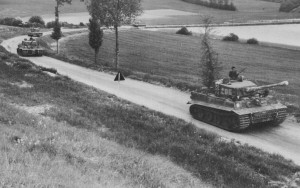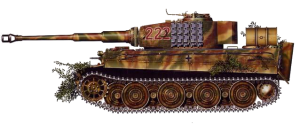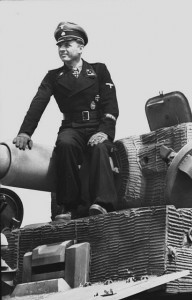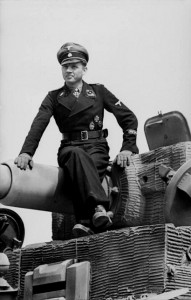“…the decision was a very, very difficult one. Never before had I been so impressed by the strength of the enemy as I was by those tanks rolling by; but I knew it absolutely had to be and I decided to strike out into the enemy.”
Michael Wittmann, 13th June 1944
Background to the battle
In the wake of the D-Day landings on 6th June 1944, the Allies had made rapid progress inland in what became the Battle of Normandy. In the days following the invasion Allied ground forces commander General Bernard Montgomery initiated Operation Perch, with the target being the strategically important port city of Caen.
With the beleaguered German forces now being squeezed on both fronts, a number of the premier units found themselves leaving the Eastern Front and heading west. Among them was the I SS Panzer Corps, which included Michael Wittmann’s 2. Kompanie of the 101st SS Heavy Panzer Battalion (Schwere SS-Panzer-Abteilung 101).
By 12th June, Allied formations including the 22nd Armoured Brigade of the famous 7th Armoured Division (the “Desert Rats”) had reached the outskirts of the city. Having initially sliced through the fast-retreating German defences with relative ease, things had begin to slow down after a series of hard-fought battles near the town of Tilly-sur-Seulles – defended by the well-equipped Panzer-Lehr Division. Nevertheless, the flanks of the Panzer-Lehr had been massively exposed – setting up the possibility of their being completely enclosed by the fast-advancing Allied forces.
Central to the Allied plan was the main trunk road towards Caen, and the high ground located at Hill 213 (also known as Point 213). Right in the middle of the path was the small, compact town of Villers-Bocage. Under the command of Brigadier William “Loony” Hinde, the British formations had continued without incident, making the outskirts of the town by the morning of 13th June.
Meanwhile, Waffen-SS divisional commander SS-Obergruppenführer “Sepp” Dietrich had already anticipated the move by the British. The Panzers were back on the move, and Michael Wittmann and his small squad of Tigers were ordered to make their way to the area from their base camp in Beauvais.
Although the 101st would have a full theoretical strength of forty-five Tiger Is, Wittmann’s 2. Kompanie arrived at the front after the five day drive to Villers-Bocage from their base near Beauvais with just five (or possibly six) fully serviceable vehicles.(1)
The arduous 240-kilometre journey had been fraught with danger: apart from the mechanical problems that had taken their toll on the Tigers en route, the constant threat from the air from the dreaded fighter-bombers (Jagdbombers, or Jabos) constantly played on the minds of the frazzled Panzer crews. Almost complete Allied air superiority meant that any attempt to move during daylight was too much of a risk, and the Tigers were forced to make the journey at night.
Arriving on 12th July, Wittmann’s Tigers positioned themselves south of Point 213 on the Villers-Bocage ridge close to the Vire-Caen road in support of both Panzer-Lehr and another Waffen-SS Panzer division, the 12th Hitlerjugend. Not far behind Wittmann’s group were the Tigers of SS-Hauptsturmführer Rolf Möbius’s 1. Kompanie, with SS-Obersturmführer Hanno Raasch’s 3. Kompanie a further two days behind.

The build up: Morning, 13th June 1944
On the morning of 13th June, the available LSSAH panzer unit commanders conferred with “Sepp” Dietrich to discuss their plan of action. The general feeling was that the Allies were about to launch a massive thrust with the aim of outflanking Panzer-Lehr; it was concluded that the targets to secure were Villers-Bocage itself and Hill 213, which was located close to the main crossroads north of the town.
The scene had been set for what was essentially a simple race for tactical supremacy, though nobody could possibly predict the events that were to follow. Wittmann suggested that his Tiger carry out a soft reconnoitre of the surrounding area, a plan to which his battalion commander instantly agreed.
Wittmann’s assigned role was one of simply checking out enemy movement in the area around Villers-Bocage, which had been cited by Dietrich and Hitlerjugend commander SS-Oberführer Kurt “Panzer” Meyer as being essential to securing a crucial foothold in the area. Wittmann set out towards Villers-Bocage at around 06:00, moving cautiously alongside a wooded area south of the Route Nationale (RN) 175 in order to avoid being spotted from the air.
Unknown to him, the British had already set out earlier in the morning, and were already on their way to Villers-Bocage with the intention of taking Hill 213 themselves and securing the road to Caen.
While at his command post located some 150 metres from Hill 213, Wittmann encountered an Army sergeant who informed him of the presence of a number of unfamiliar vehicles in the vicinity. Wittmann then spotted what looked like a never-ending convoy of British and American type vehicles casually rolling along the highway, heading out of Villers-Bocage towards Hill 213. It turned out that these vehicles were the lead element of a highly-trained British unit, the 4th County of London Yeomanry (4CLY, “Sharpshooters”), part of the 22nd Armoured Brigade of the 7th Armoured Division – the renowned “Desert Rats”.
Equipped with both Mk. IV Cromwell cruiser tanks and M4A4 Sherman VC Firefly medium tanks, “A” Squadron 4CLY had positioned themselves east of the settlement. Meanwhile, 4CLY’s “B” Squadron were stationed west of Villers-Bocage, overseeing the intersection with the road leading to the neighbouring village of Caumont with 4CLY’s Regimental Headquarters situated in the main street of Villers-Bocage itself.
Directly behind “A” Sqn. were A Company of the 1st Rifle Brigade, which was equipped with eight M5A1 half-tracks, four Mk. II universal and Loyd carriers and three Stuart M3A3 “Honey” light tanks.
The Allies had been completely unaware of the presence of the German Panzers in the area; the 4CLY’s commanding officer Lt-Colonel Arthur, the Viscount Cranleigh, had requested time to carry out a proper reconnaissance of the area but this was ignored as the order was issued to proceed regardless. Nevertheless, any lingering doubts would have been put aside after a trouble-free entry for the British column into Villers-Bocage, where they had been warmly greeted by enthusiastic residents.
Despite Cranleigh’s initial reservations the column pressed on towards Hill 213, unaware that their movement was being closely observed. According to the account of Major Ian “Ibbie” Aird, leader of “B” Squadron 4CLY,
The orders were to push on as fast as possible, there being no further opposition from the crossroads area. The country was very close, the road wandering over switchback hills, gradually swinging east towards Villers. Within a few hours, the leading elements, moving fast, were in sight of the small town. From Brigade came the information that the place was clear of the enemy and the cheering villagers on the side of the road seemed to confirm it. In consequence, A Squadron galloped through the town, seeing no signs of Germans, and reached their objective on the farther side, a hill which commanded the road to Caen.(2)
Wittmann’s Dilemma
This rather enticing opportunity provided Wittmann with something of a dilemma: he clearly felt that he could not allow this situation to escape him, yet any radio contact with HQ would have been instantly intercepted by the enemy. More crucially Wittmann noted that there were few German forces of substance in the immediate vicinity to provide any additional support, and that if left unchecked the British column would have had a clear and unobstructed route though to the town of Caen. The situation helped to make his mind up for him. There was no time for dithering.
With his own command Tiger 205 out of commission, Wittmann would have only five Tigers at his disposal: 221 (SS-Untersturmführer Georg Hantusch), 222 (SS-Unterscharführer Kurt Sowa), 223 (SS-Oberscharführer Jürgen Brandt), 233 (SS-Oberscharführer Georg Lötzsch), and 234 (SS-Unterscharführer Herbert Stief). Of these half-dozen vehicles, 233 had track damage and SS-Obersturmführer Jürgen Wessel in 211 was not present, having departed for the front earlier in the morning to receive orders. It was at this moment that Wittmann decided to take action himself. He recalled that the decision was a tough one, one that required split-second thinking:
“…the decision was a very, very difficult one. Never before had I been so impressed by the strength of the enemy as I was by those tanks rolling by; but I knew it absolutely had to be and I decided to strike out into the enemy.”
Leaving the infantry sergeant safely in his foxhole, Wittmann sprinted towards Stief’s Tiger 234 as it was the vehicle closest to him. The vehicle’s commander, who had previously been taking a short nap, was quickly dispatched to brief the remaining members of the platoon. The driver cranked up the engine. However, after rolling forward some twenty-five or so yards Wittmann sensed that something not quite right. SS-Rottenführer Walter Lau, Stief’s gunner, was not to know what he would miss out on as the next vital minutes unfolded.
Without a moment of hesitation Wittmann leapt out and sprinted towards the next available Tiger – 222, that of of SS-Unterscharführer Kurt Sowa, which had by this time made its way out of the defile.
Which Tiger?
The turret number of the vehicle Wittmann actually commandeered on the morning of 13th June 1944 has continued to be a subject of enthusiastic debate among historians of the battle; Sowa’s assigned vehicle at the time of the battalion’s formation had been 222, and it is this vehicle that has been cited by the majority of commentators as being the one Wittmann climbed into prior to his initial advance on Villers-Bocage.
The historian Daniel Taylor has presented a series of arguments that suggest the vehicle Wittmann took into Villers-Bocage might well have been SS-Untersturmführer Heinz Belbe’s Tiger Nr. 231, which had not been among the six serviceable Tigers listed by both Patrick Agte and George Forty in their studies of the battle. Others meanwhile have mentioned Tiger 212 – assigned to Wittmann’s former gunner Bobby Woll – which had also not been on the list of serviceable vehicles.

There are a number of possible reasons for this, most of which stem from the (assumption?) that Sowa’s tank was in fact his assigned 222. It is fairly well-known that the Tigers were prone to mechanical failure, and as a result commanders had got used to what could best be described as “tank-hopping”. It could well have been that by this stage of the campaign Sowa’s assigned vehicle might itself have been undergoing maintenance, and that on the day of the attack on Villers-Bocage he may have been in command of Belbe’s 231 and not his designated vehicle. Thus, “Sowa’s Tiger”, which everyone who has written on the subject is agreed that Wittmann commandeered on the morning of 13th June, might have been 231 instead of 222. Or even 212 for that matter.
Somewhat frustratingly, it hasn’t helped that postwar researchers have not had the luxury of having any actual footage or photographs of Wittmann setting out for the N 175 on the morning of 13th June – and as a result this discussion will continue to rumble on without any real hope of a satisfactory resolution.
Instead of theorising too much on the what ifs, I have decided simply to base my version of events on the central assumption that by “Sowa’s Tiger” Wittmann meant 222. Given that this vehicle was among the six Tigers listed as being serviceable that morning, it is far more likely that this was the vehicle that had entered Villers-Bocage under Wittmann’s command.
Settled in the cupola of Tiger 222, Wittmann would give the order to his “new” driver – SS-Unterscharführer Walter Müller – to crank up the vehicle for an all out attack on the enemy formation. Also on board were his gunner Bobby Woll, loader SS-Sturmmann Günter Boldt, and radio operator SS-Sturmmann Günther Jonas.
There has also been some debate as to whether Woll had been on board Wittmann’s Tiger, but again with there being no solid evidence either way it is difficult to be absolutely certain. Some sources have pointed out that Woll had not been at the front at that time, but given the situation – had he been available – one could think of no better person to have manning the 88mm cannon for such a risky endeavour.
The order was issued for all the remaining Tigers to stand fast and host their positions; Sowa, whose vehicle had been commandeered by Wittmann moments earlier, would in turn take charge of Stief’s partially-abled 234, rolling it into a safe defensive position on the highway. The other vehicles at the ready were Hantusch’s 221 and Brandt’s 233. The time was now 08:35.


